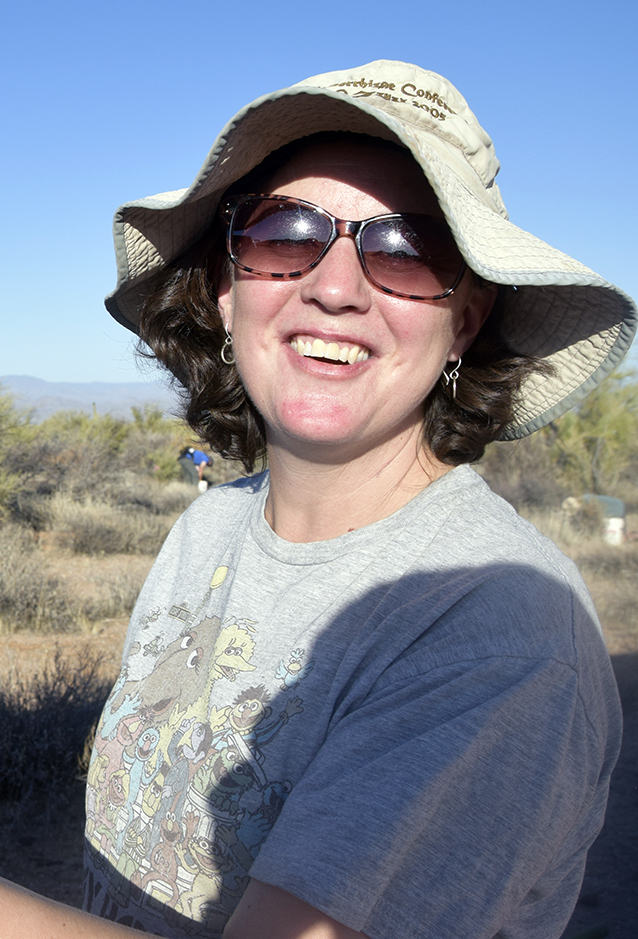On most desert trails, recreationists will see a sign that says “don’t bust the crust!” The cheeky phrase is asking people to avoid disturbing the delicate dryland ecosystems of biocrust and soil organisms that typically exist just off trail: even one step on biocrust can wreck it. But why are these ecosystems so important?
Science Moab discussed this with Dr. Anita Antoninka, an assistant research professor at the Northern Arizona University School of Forestry. She is a soil, plant, community and restoration ecologist, and we chatted with her about her recent research on developing methods for dryland restoration using biocrusts and other soil organisms.
Science Moab: What are we talking about when we say “biological soil crust”?
Antoninka: Biological soil crust, or biocrust, is a community or consortium of organisms including mosses, lichen, cyanobacteria and algae that live together and bind the top five millimeters of soil together. They’re really critical in dryland ecosystems because they keep the soil in place, keep water in place, fertilize the soil through nitrogen fixation, and contribute to soil fertility through collecting dust that has nutrients in it.
Science Moab: What work do you do at the Rangeland Soil Ecology Lab at NAU?
Antoninka: Drylands encompass more than just deserts: a lot of it is rangeland, where there have been cattle grazing or mineral exploration that affected the integrity of the landscape. At the lab, we develop technologies to restore these damaged drylands.
Our work also includes forests: forest fires lead to the loss of soil, loss of soil stability, and erosion on the landscape. Biocrust can be really important for that rehabilitation process.
Science Moab: What are some of your rehabilitation projects?
Antoninka: There are a lot of different things that go into restoring an ecosystem. The first thing is to assess what the major issues on the landscape are and what the major limitations to restoration are.
For example, if you have active soil erosion, the first thing that you have to do is figure out a way to stabilize the soil so that you can get organisms to colonize and survive there. Those are the sorts of things that we think about as we prepare a recipe for restoration: are there any biocrusts that we can actually use in the restoration? If the biocrust in an area is very limited, then we’ll salvage and cultivate more biocrust. We’ve been working a lot on that area, growing biocrusts in ways that we can maximize their growth in the most rapid way possible. We can grow a more mature biocrust in a few months by reducing water limitation, nutrient limitation, and competition with the surrounding plants.
The next piece of that is cultivating them in a way that when we put them back out on the landscape, they’ll survive. Think about your backyard tomato plants: you don’t just take them from your windowsill and put them directly out in the garden, you give them a period of hardening. We’ve been working on ways that we can harden the biocrust to be resilient in this harsh landscape, but also ways we can soften the environment—we can add shade in some way, to help the biocrust establish more quickly.
Science Moab: Is there anything you can proactively do to help biocrust?
Antoninka: The first thing that we can consider is reducing our footprint. If we can conserve lands and stop activity on lands that are in good shape, we can keep biocrust communities and the vascular plant communities and functions intact.
If we see that we’re starting to cause damage, by removing the activity that is causing the disturbance and leaving it alone, the ecosystem has a chance to bounce back. Oftentimes, if you don’t have active soil erosion, the community can reset itself through time.
Science Moab: How difficult is it working across various agencies to try and get the research activated in the field?
Antoninka: One of the really cool things about the biocrust research community is that it’s super collaborative. We have this really cool niche of cutting-edge science, restoration-minded science, and the land management community. One of the things that gives me hope is that a lot of people recognize that this is important: it’s not just scientists talking to scientists, it’s scientists engaging with land managers and land managers asking for help, which I think is critical to make anything fly.
Science Moab is a nonprofit dedicated to engaging community members and visitors with the science happening in Southeast Utah and the Colorado Plateau. To learn more and listen to the rest of this interview, visit www.sciencemoab.org/radio.




